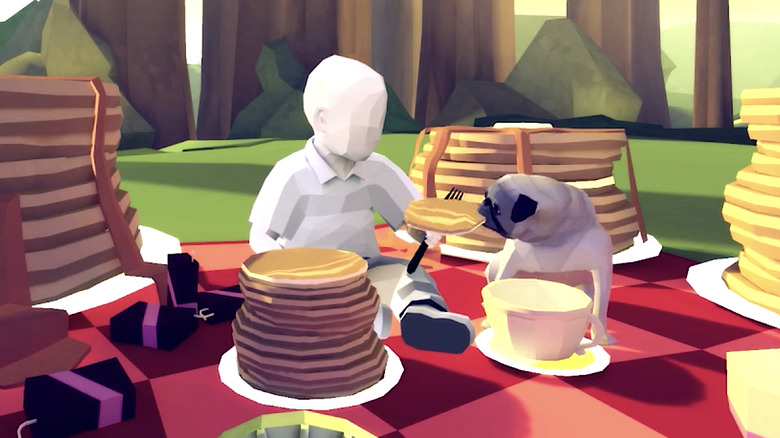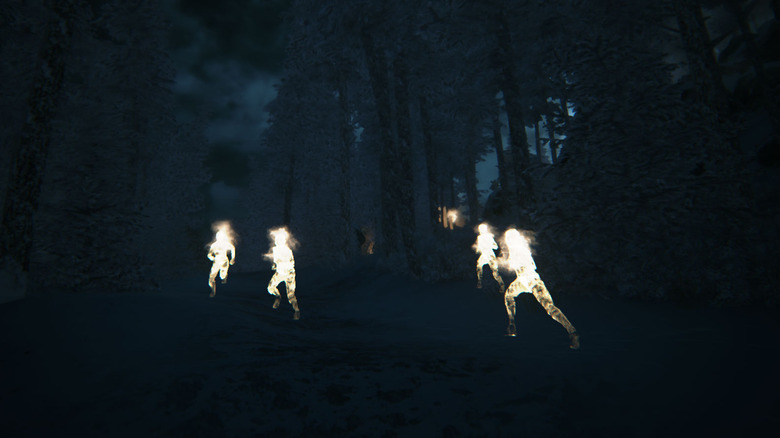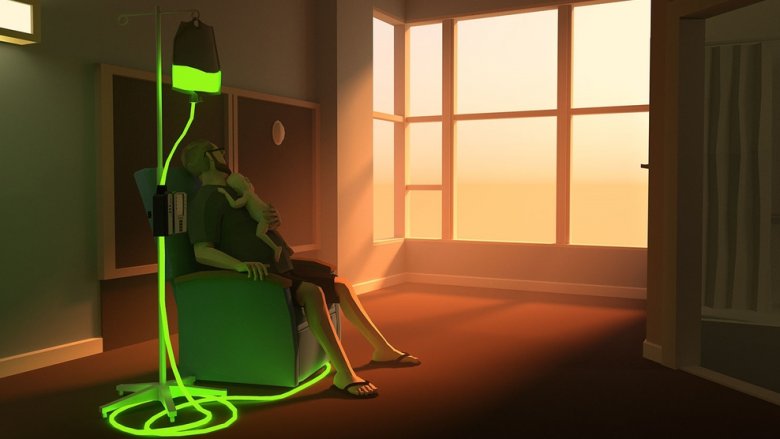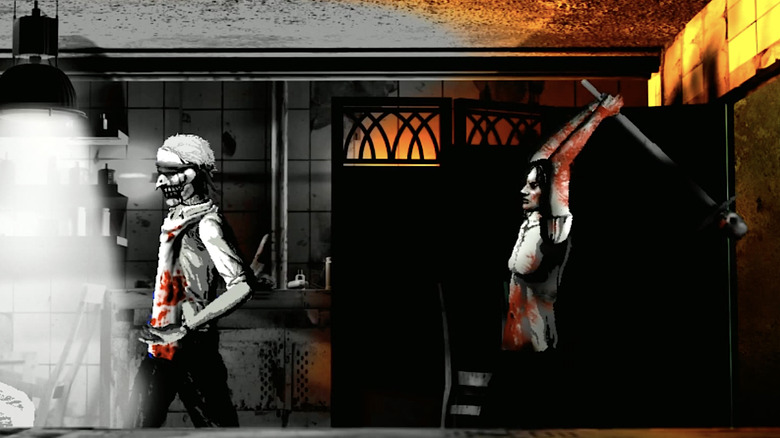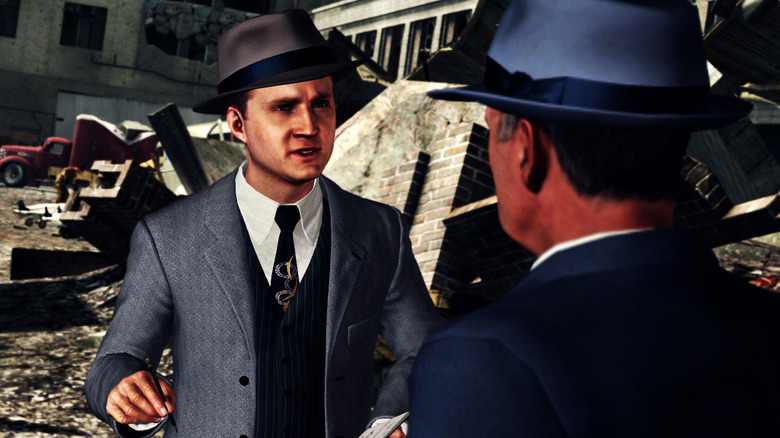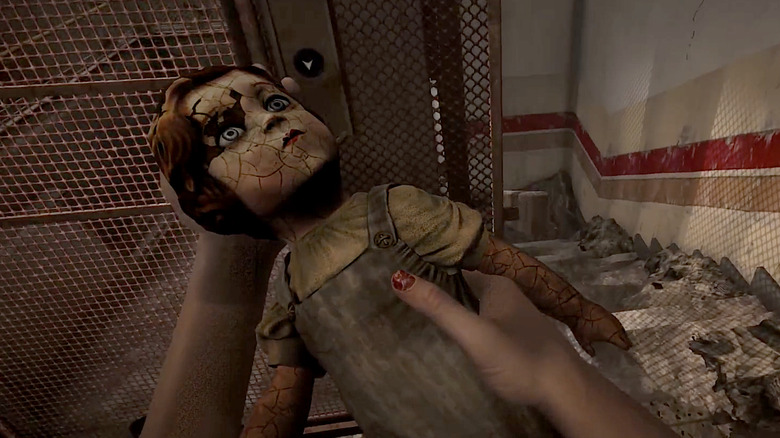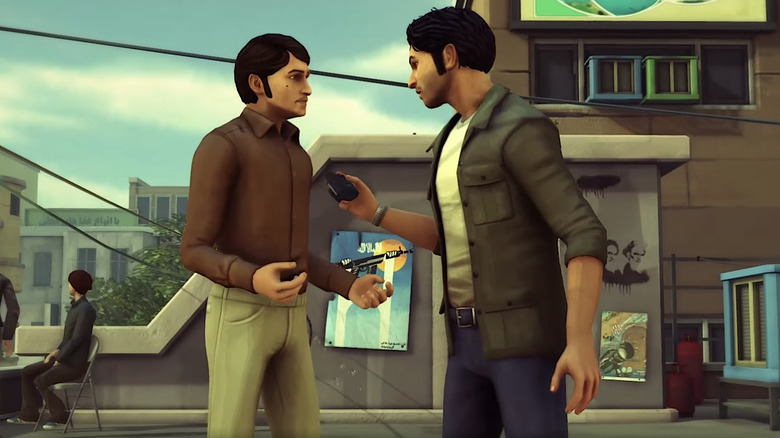Video Games You Didn't Know Were Inspired By Disturbing True Events
As the old saying goes, art imitates life. Unfortunately, real life isn't all sunshine and rainbows. Some of history's most macabre, mysterious, and heartbreaking events have gone on to inspire developers looking to pepper a little realism into their games. From titles that unflinchingly portray their developers' personal trauma to adventures that reimagine history's most heinous crimes, these video games prove that truth is stranger than fiction. Let's take a look at video games that most players don't realize are based on disturbing true events.
Kholat
Real-life mysteries are far more frightening than fictional phenomena—especially when they've gone unsolved for decades. Based on the infamous Dyatlov Pass Incident, IMGN.PRO's snowy survival-horror game Kholat chronicles the journey of a protagonist (voiced by Sean Bean) as he retraces the footsteps of a group of young Russian hikers who met their ends under mysterious circumstances in February of 1959.
To this day, the Dyatlov Pass Incident (named after one of the hikers, Igor Dyatlov) continues to perplex both experts and amateur sleuths alike, and for good reason. It's not everyday that experienced hikers rip open their tent in the middle of the night and run into the woods in their underwear, only to suffer inexplicable fractures, absorb high levels of radiation, and adopt a "reddish-orange hue." While skeptics believe that the threat of an avalanche compelled the group to hoof it in the wilderness, that theory—and the autopsies' claims that the group had succumbed to hypothermia—don't account for half of the case's other mysteries.
While 2015's Kholat takes plenty of creative liberties in delivering a supernatural take on the strange events surrounding the tragic tale, it otherwise faithfully captures the traumatic feeling of being stranded on a snowy mountain and forced to fight for survival in the face of nature's cruelty.
That Dragon, Cancer
Spooking players isn't the only way to evoke a strong emotional response. Take, for example, Numinous Games' That Dragon, Cancer. Developed by Ryan and Amy Green in collaboration with a small team, the notorious tearjerker depicts the couple's coming to grips with their young son Joel's terminal cancer. The heartbreaking indie gem plays out more like an interactive memoir than a traditional video game, offering gamers a heart-wrenching look at the unbreakable bonds of the Green family through a series of segments that blur the lines between fantasy and reality.
The biographical That Dragon, Cancer, which won a number of prestigious awards including a Matthew Crump Cultural Innovation Award, proves that video games have the potential to move those lucky enough to play them in ways that other, less interactive mediums can't. It isn't often that gamers are afforded such an up-close and personal glimpse into a family's most personal—and tragic—memories.
The Cat Lady
Like That Dragon, Cancer, The Cat Lady embraces a very specific narrative tone. However, while the former opts for a quiet, somber atmosphere, Harvester Games' moody puzzler wears its hopeless melancholy on its sleeve. The game, which begins with protagonist Susan Ashford downing a bottle of sleeping pills, was inspired by stories of depression told to creator Remigiusz Michalewski by family, friends, and patients admitted to the Exeter hospital where he works as an auxiliary nurse. Judging from the game's gore-laden environments and creepy-crawly art style, it would seem that he's taken cues from the injuries he's seen at his place of work as well. The Cat Lady triumphs as an in-depth portrait of the surreal nightmare that are the minds of severely depressed individuals as they attempt to take their own lives.
L.A. Noire
With its 1940s Los Angeles setting—and gritty themes like crime and corruption—it comes as no surprise that Rockstar's pulpy L.A. Noire would borrow from the real world. The creators behind the sleuthing simulator adopted some of history's most grisly homicides, forcing players to put their investigative skills to the test in a series of increasingly challenging cases. One notable example of Rockstar's penchant for reworking reality to fit into their game's narrative relates to "The Quarter Moon Murders" case, which sees protagonist Cole Phelps solving a series of crimes committed by the same man who ended the life of Elizabeth Short in 1943. If Short's name sounds familiar, that's because she was the real-life "Black Dahlia," a Hollywood hopeful who's gone down in history not for her acting talent, but for the tragic unsolved case that's become synonymous with her moniker.
YIIK
Ackk Studios' postmodern homage to JRPGS YIIK might still be in development, but that doesn't mean it hasn't caused quite a stir in the indie video game scene. The old school turn-based title, which features a group of record-collecting, keytar-playing hipsters investigating the disappearance of their friend Semi "Sammy" Pak, is loaded with quirky characters and surreal environments. It also looks like it'll have its fair share of scares considering it takes inspiration from the enigmatic death of Canadian student Elisa Lam.
The forthcoming role-playing game centers around a chilling video depicting Sammy Pak being "pulled from an elevator by something otherworldly"—an obvious nod to the eerie Cecil Hotel elevator surveillance footage of Lam that went viral after her case gained attention in 2013. While the real-life circumstances of Lam's death remain shrouded in mystery—despite it being ruled accidental—YIIK puts a supernatural twist on the tragedy, blaming paranormal forces for the vanishing of Elisa Lam-lookalike Sammy Pak.
The Town of Light
Today, open-world games are a dime a dozen—so titles like The Town of Light are refreshing reminders that you really only need one spooky setting to creep the bejesus out of players. Equal parts poignant and skin-crawling-ly creepy, LKA's The Town of Light takes place within a painstakingly accurate digital replication of Italy's Ospedale Psichiatrico di Volterra—or Volterra Psychiatric Hospital. And while the developers adamantly deny that their game falls into the "horror" genre, opting instead for the "psychological thriller" classification, it sure knows how to instill a sense of dread as young protagonist Renée confronts her past abuse upon returning to the now-derelict asylum.
In order to develop a realistic foundation for their game, LKA collected countless letters, personal accounts, and published materials written by former patients of Volterra who'd suffered at the hands of the hospital staff. Their aims in embracing such real-life atrocities are twofold: they sought to faithfully recreate one of Italy's darkest secrets—and, as the team told Rock Paper Shotgun, "... make people aware of things that no-one talks about really."
1979 Revolution: Black Friday
The Iranian Revolution saw a period of citizen unrest, hostage crises, and, ultimately, the overthrow of Shah Mohammad Reza Pahlavi. While these events sound right at home in a History Channel documentary, Navid Khonsari's 1979 Revolution: Black Friday allows gamers to leap into the shoes of fictional photographer Reza Shirazi and explore the period's troubling events.
Based on testimonies from freedom fighters, witnesses, casualties, and imprisoned civilians, 1979 Revolution doesn't shy away from portraying the real-life horrors of life under an oppressive autocracy. Nor does it coddle players by offering them one "right" way to reach their end-game. Each potential narrative path is firmly rooted in a realistic sense of moral ambiguity, whether players choose peaceful protest, violent revolution, or complacency. As was the case during the real-life revolution, Khonsari's game argues that no course of action is perfect, and political corruption, conflict, and bloodshed are not only possible—they're inevitable.
The Sims
If you ignore the Grim Reaper, the cringe-inducing glitches, and players' penchants for dispatching of their Sims in creative ways, Will Wright's popular life simulation series The Sims is a pretty light-hearted affair. In preparation to build the virtual dollhouse of his dreams, Wright took inspiration from a wide variety of sources, including community-focused games like Quake, books like Christopher Alexander's A Pattern Language, and even Abraham Maslow's "A Theory on Human Motivation." However, it wasn't until the Oakland-Berkeley Firestorm of 1991, which displaced his family and forced him to re-purchase all of his earthly possessions, that Wright realized something pivotal about his forthcoming game: the Sims required a basis for their happiness.
In an interview with Berkeleyside, Wright explained this revelation: "I started to wonder about all the things we have and how we purchased them for a reason. Why do we need x or y or z? Why do we think something will make me happier?" Pondering the true meaning of happiness as it relates to material possessions, Wright was inspired to draft his first incarnation of The Sims' "happiness landscape," which allows Sims to "map and identify what items would satisfy any pending needs."

